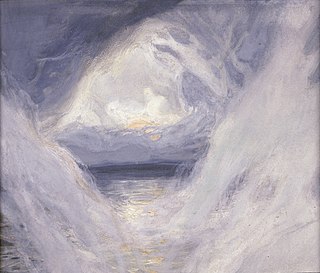
A creation myth is a symbolic narrative of how the world began and how people first came to inhabit it. While in popular usage the term myth often refers to false or fanciful stories, members of cultures often ascribe varying degrees of truth to their creation myths. In the society in which it is told, a creation myth is usually regarded as conveying profound truths – metaphorically, symbolically, historically, or literally. They are commonly, although not always, considered cosmogonical myths – that is, they describe the ordering of the cosmos from a state of chaos or amorphousness.
Hecate or Hekate is a goddess in ancient Greek religion and mythology, most often shown holding a pair of torches, a key, snakes or accompanied by dogs and in later periods depicted in triple form. She is variously associated with crossroads, entrance-ways, night, light, magic, witchcraft, knowledge of herbs and poisonous plants, ghosts, necromancy, and sorcery. Her earliest appearance in literature was in Hesiod's Theogony in the 8th century BCE as a goddess of great honour with domains in sky, earth, and sea. Her place of origin is debated by scholars, but she had popular followings amongst the witches of Thessaly and an important sanctuary among the Carian Greeks of Asia Minor in Lagina.
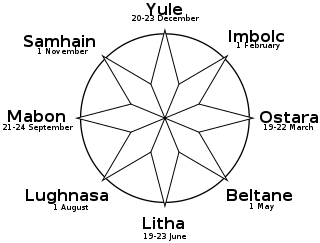
The Wheel of the Year is an annual cycle of seasonal festivals, observed by many modern Pagans, consisting of the year's chief solar events and the midpoints between them. While names for each festival vary among diverse pagan traditions, syncretic treatments often refer to the four solar events as "quarter days", with the four midpoint events as "cross-quarter days". Differing sects of modern Paganism also vary regarding the precise timing of each celebration, based on distinctions such as lunar phase and geographic hemisphere.

Witchcraft traditionally means the use of magic or supernatural powers to harm others. A practitioner is a witch. In medieval and early modern Europe, where the term originated, accused witches were usually women who were believed to have attacked their own community, and often to have communed with evil beings. It was thought witchcraft could be thwarted by protective magic or counter-magic, which could be provided by cunning folk or folk healers. Suspected witches were also intimidated, banished, attacked or killed. Often they would be formally prosecuted and punished, if found guilty or simply believed to be guilty. European witch-hunts and witch trials in the early modern period led to tens of thousands of executions. Although some folk healers were accused of witchcraft, they made up a minority of those accused. European belief in witchcraft gradually dwindled during and after the Age of Enlightenment.
Aradia is one of the principal figures in the American folklorist Charles Godfrey Leland's 1899 work Aradia, or the Gospel of the Witches, which he believed to be a genuine religious text used by a group of pagan witches in Tuscany, a claim that has subsequently been disputed by other folklorists and historians. In Leland's Gospel, Aradia is portrayed as a messiah who was sent to Earth in order to teach the oppressed peasants how to perform witchcraft to use against the Roman Catholic Church and the upper classes.
In Latvian mythology, the term Māte stands for "mother", sometimes written in English as Mahte. It was an epithet applied to some sixty-seventy goddesses. They were clearly distinct goddesses in most or all cases, so the term definitely referred to the mother-goddess of specific phenomena. According to professor Lotte Motz, scholar Haralds Biezais mentioned there were at least 70 characters in Baltic religion identified with the title of Mate.

Nut, also known by various other transcriptions, is the goddess of the sky, stars, cosmos, mothers, astronomy, and the universe in the ancient Egyptian religion. She was seen as a star-covered nude woman arching over the Earth, or as a cow. She was depicted wearing the water-pot sign (nw) that identifies her.

Traditional Sámi spiritual practices and beliefs are based on a type of animism, polytheism, and what anthropologists may consider shamanism. The religious traditions can vary considerably from region to region within Sápmi.

The Goddess movement includes spiritual beliefs or practices which emerged predominantly in North America, Western Europe, Australia, and New Zealand in the 1970s. The movement grew as a reaction to perceptions of predominant organized religion as male-dominated, and makes use of goddess worship and can include a focus on female people, or on one or more understandings of gender or femininity.
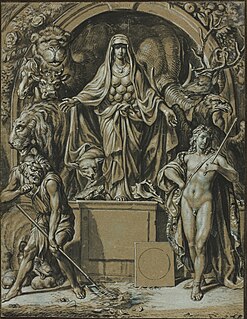
Mother Nature is a personification of nature that focuses on the life-giving and nurturing aspects of nature by embodying it, in the form of the mother.
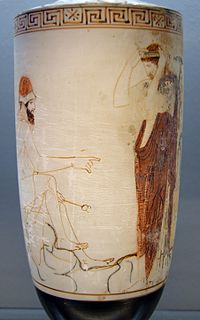
In mythology, the Greek underworld is an otherworld where souls go after death. The original Greek idea of afterlife is that, at the moment of death, the soul is separated from the corpse, taking on the shape of the former person, and is transported to the entrance of the underworld. Good people and bad people would then separate. The underworld itself—referred to as Hades, after its patron god—is described as being either at the outer bounds of the ocean or beneath the depths or ends of the earth. It is considered the dark counterpart to the brightness of Mount Olympus with the kingdom of the dead corresponding to the kingdom of the gods. The underworld is a realm invisible to the living, made solely for the dead.
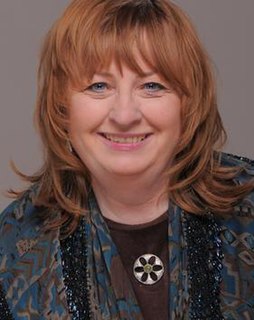
Patricia Monaghan was a poet, a writer, a spiritual activist, and an influential figure in the contemporary women's spirituality movement. Monaghan wrote over 20 books on a range of topics including Goddess spirituality, earth spirituality, Celtic mythology, the landscape of Ireland, and techniques of meditation. In 1979, she published the first encyclopedia of female divinities, a book which has remained steadily in print since then and was republished in 2009 in a two volume set as The Encyclopedia of Goddesses and Heroines. She was a mentor to many scholars and writers including biologist Cristina Eisenberg, poet Annie Finch, theologian Charlene Spretnak, and anthropologist Dawn Work-MaKinne, and was the founding member of the Association for the Study of Women and Mythology, which brought together artists, scholars, and researchers of women-centered mythology and Goddess spirituality for the first time in a national academic organization.

Anu, Anum, or Ilu, also called An, is the divine personification of the sky, supreme god, and ancestor of all the deities in ancient Mesopotamian religion. Anu was believed to be the supreme source of all authority, for the other gods and for all mortal rulers, and he is described in one text as the one "who contains the entire universe". He is identified with the part of the sky located between +17° and -17° declination which contains 23 constellations. Along with his sons Enlil and Enki, Anu constitutes the highest divine triad personifying the three bands of constellations of the vault of the sky. By the time of the earliest written records, Anu was rarely worshipped, and veneration was instead devoted to his son Enlil. But, throughout Mesopotamian history, the highest deity in the pantheon was always said to possess the anûtu, meaning "Heavenly power". Anu's primary role in myths is as the ancestor of the Anunnaki, the major deities of Sumerian religion. His primary cult center was the Eanna temple in the city of Uruk, but, by the Akkadian Period, his authority in Uruk had largely been ceded to the goddess Inanna, the Queen of Heaven.

The Ainu creation myths are the traditional creation accounts of the Ainu peoples of Japan. Their stories share common characteristics with Japanese creation myths and earth diver creation stories commonly found in Central Asian and Native American cultures. Ainu mythology divides time into three tenses: "Mosir sikah ohta", "mosir noskekehe", and "mosir kes". In one version, the creator deity sends down a water wagtail to create habitable land in the watery world below. The little bird fluttered over the waters, splashing water aside, and then he packed patches of the earth firm by stomping them with his feet and beating them with his tail. In this way, islands where the Ainu were later to live were raised to float upon the ocean.

Ngombe, or Lingombe, is a Bantu language spoken by about 150,000 people in the Democratic Republic of the Congo. In general, native speakers live on either side of the Congo river, and its many tributaries; more specifically, Équateur Province, Mongala District and in areas neighboring it. Ngombe is written in Latin script.

Cerridwen Fallingstar, is an American Wiccan priestess, shamanic witch, and author. Since the late 1970s she has written, taught, and lectured about magic, ritual, and metaphysics, and is considered a leading authority on pagan witchcraft.
Akongo is a Creator God in African mythology. He is worshipped by the Ngombe people of the Congo.
Atira, literally "our mother" or "Mother (vocative)", is the title of the earth goddess in the Native American Pawnee tribal culture.

The "creation of life from clay" is a miraculous birth theme and scientific study that appears in mythology, literature, and modern theory.